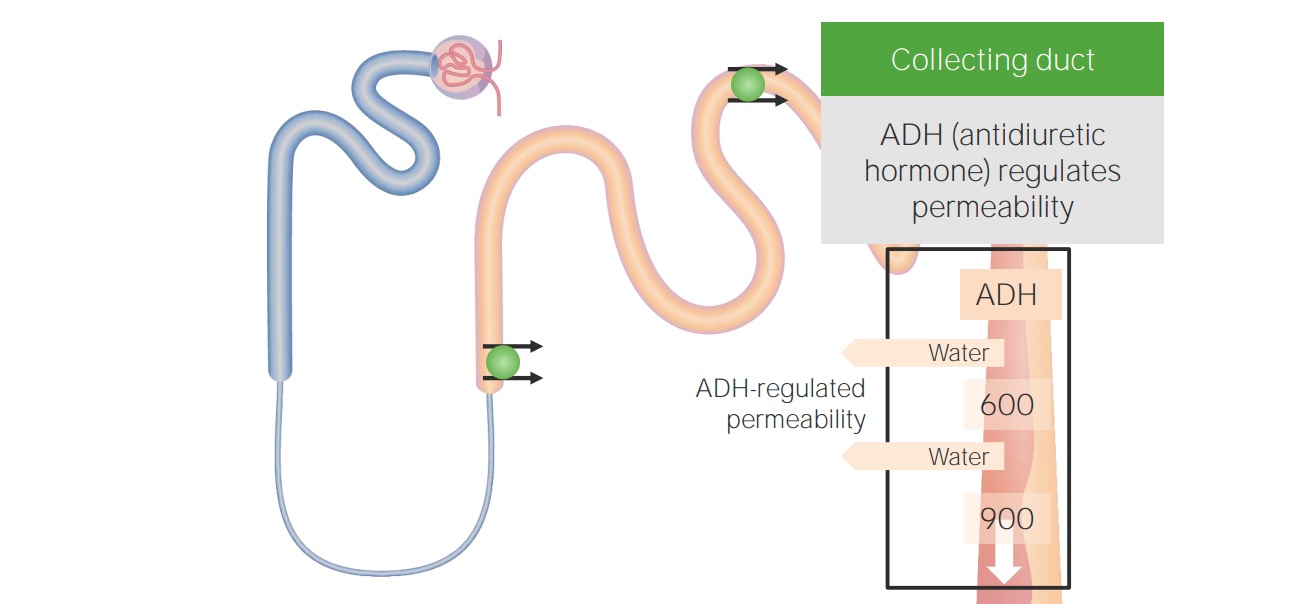Playlist
Show Playlist
Hide Playlist
Hypernatremia: Management
-
Slides Water Balance Hypo and Hypernatremia.pdf
-
Download Lecture Overview
00:01 So in managing our hypernatremic patients, we have to target not only the underlying cause, but we also want to do interventions that limit further water loss. 00:10 So in targeting the underlying cause, we want to correct the hypertonicity. 00:14 by administering dilute fluids and free water. 00:17 We can actually calculate this by looking at the water deficit. 00:20 So that means we can take our patient's current total body water. 00:24 We multiply that by their serum sodium divided by their desired serum sodium, which is typically normal at 140. 00:30 And subtracting one from that. 00:33 Now, in addition to correcting just their water deficit, you also want to make sure that you are targeting any ongoing water losses. 00:41 So that means insensible losses just breathing or sweating. 00:44 In addition to any urinary losses or stool losses that that patient might be incurring. 00:50 Now, what kind of interventions can we do to further limit water loss? Well, in the case of somebody who has, for example, central diabetes insipidus, then we can actually administer Desmopressin, an ADHD analog in order to correct their water deficit, and help them to retain water. 01:09 So, I do want to just take a moment to talk about administering parenteral fluid in the management of hypernatremia patients. 01:15 So remember, we talked about being able to correct their water deficit. 01:19 Now, if a patient's thirst is intact, they can do that by drinking, or taking oral intake. 01:24 But if a patient has impaired thirst, or if they're in a situation where they don't have free access to water, then we can use things like parenteral water. 01:34 And we do this in our critically ill population, perhaps who are intubated, and in the intensive care unit. 01:41 So how about our patients who are hypovolemic and hypernatremic. 01:45 Remember, those are patients who are both volume depleted and dehydrated because they have both sodium and water losses. 01:52 If they don't have free access to water, we can give them something like half normal saline, which is going to both restore their vascular volume and at the same time replace their water deficit. 02:03 And our patients who are euvolemic and hypernatremic. 02:07 This means that they're dehydrated only due to water losses, then we can use if need be parenteral free water. 02:13 And that's given in the form of 5% dextrose in water. 02:17 Remember, we can't get pure water IV because the hypotonicity will cause lysis of cells. 02:23 Now, if thirst mechanism that is intact, and the patient can take oral intake, then we want to provide access to free water. 02:30 Similarly, if a patient has an NG tubing or a do tubing then we can provide enteral free water as well. 02:38 So, I do want to mention that you have to be cautious with correcting hypernatremia in the chronic state. 02:43 So if somebody has been hypernatremic for greater than 48 hours duration, then it's important not to correct that serum sodium greater than 10 mEq over a 24 hour period of time. 02:53 Otherwise, that patient may be at risk for cerebral edema. 02:57 So just to remind you both hyponatremia and hypernatremia, serum sodium needs to be monitored and followed very closely. 03:05 Meaning that you need to check it somewhere between two and four hours. 03:08 And therapy should be modified accordingly so that you avoid too rapid of a correction. 03:15 So let's review again the effects of hypernatremia. 03:17 And what happens if we correct our patients too quickly. 03:20 Just to remind ourself in the hypernatremic state, where our patients have a high osmolality, those neuronal cells are actually decreased in size and cell volume. 03:31 Now, remember what happens adaptively. 03:33 Initially, you have movement of ions into those neuronal cells, water will follow restoring the cell volume back to the normal state. 03:40 In the chronic situation, meaning that if it's been greater than 48 hours, then we have organic osmolytes that move from the ECF into that cell volume and water will follow. 03:49 Again, restoring those cells back to the normal cell volume. 03:52 Now what happens if all of the sudden we provide hypotonic fluid? We're going to lower that serum osmolality and guess what happens, where's that water going to go? It's going to move to the intracellular compartment because two-thirds of water distributes to that intracellular compartment. 04:09 When that happens, remember what happens with those neuronal cells, they're enclosed in a rigid calvarium and therefore those patients are at great risk for actually having cerebral edema. 04:19 So we have to be cautious about correcting patients too quickly in the hypernatremic state.
About the Lecture
The lecture Hypernatremia: Management by Amy Sussman, MD is from the course Water Balance: Hypo- and Hypernatremia.
Included Quiz Questions
Which of the following is used in the management of central diabetes insipidus?
- Desmopressin
- Lithium
- Demeclocycline
- Salt tablets
Which of the following statements is correct regarding the management of chronic hypernatremia?
- Correction of serum sodium should not exceed 10 mEq/ L/ day.
- Serum sodium should be checked every 8 hours.
- Lowering plasma sodium concentration too rapidly can lead to osmotic demyelination.
- Insensible fluid loss is insignificant; therefore, it can be neglected.
Customer reviews
5,0 of 5 stars
| 5 Stars |
|
5 |
| 4 Stars |
|
0 |
| 3 Stars |
|
0 |
| 2 Stars |
|
0 |
| 1 Star |
|
0 |






